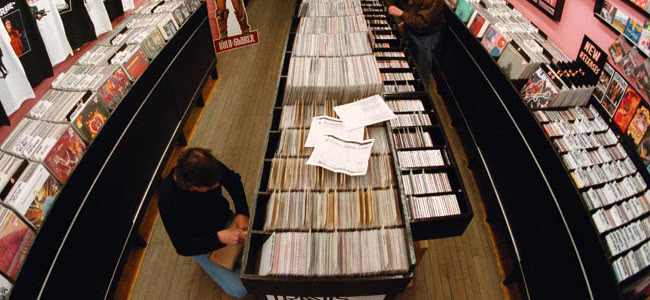With the continuing decline in physical sales and the rise of digital music ownership, and now streaming, there is an unlikely savour for young musicians looking to actually make any money off their songs – vinyl.
Recent numbers to come out of the United States show a 99.6% growth year-on-year in vinyl singles according to dollar value, as a result of a 19.7% growth in the number of units sold.
And while it’s true that vinyl sales are still dwarfed by CDs and digital downloads, the future of music in a decade looks very much like a world where consumers are split into two distinct groups – those that own vinyl, and those that stream.
Many local bands are turning to the resurrected format as a way to create a collectors item fans will buy at gigs, often offering a digital download with every purchase of a record.
It’s also been a huge boon to independent record stores who just a few years ago were written off to die a slow and painful death alongside the CD, and who have recaptured the hearts and minds of young consumers looking to connect with music in a more meaningful way than a casual stream on Spotify.
Warwick Vere, the owner of Brisbane record store Rocking Horse calls it “a colossal shift” in buying habits, “and that’s been terrific for us” he continues. “Although the numbers aren’t anywhere near the numbers of CDs, the dollar value is almost now the same, so you know, we can do a lot better actually selling less.”
Now a new film, Last Shop Standing, about ‘the rise, fall and rebirth of the independent record shop’ has retailers pitted against the labels who according to Music Week claim deliberately sabotaged vinyl by loweing the quality of the records they produced in order to speed the adoption of the CD.
“It took a few years but vinyl suddenly vanished and nobody wanted to talk about it. I had two and a half thousand record needles sat in the shop that I put in the bin,” said former High Street retailer and current Entertainment Retailers Association chairman Paul Quirk.
“We had the shop full of vinyl and we were very committed to it. What frightened us, in a way, was that Woolworth’s was saying, ‘Bring your vinyl, stick it in the bin’. They were devaluing it completely and they were taking their lead from the record companies.”
Filmmaker Graham Jones, who wrote a book on the subject before interviewing indie record store owners around the United Kingdom also claims the very vinyl used to produce the records was inferior to those before the CD.
“If you go back to the Eighties as well,” he adds. “The vinyl that we had was all recycled vinyl. So the actual quality of vinyl recordings had started to diminish. The records were thinner and more flimsy. Everything was designed for us to switch our music collection over to CD.”
Truck Store manager Gary Smith agrees that vinyl in the 80s was poor quality compared to previous decades.
“Certainly when I began in the early 80s we would get people bringing in five or six copies of the same album back because there’d be a fault in the vinyl,” he said. “The 70s vinyl seemed to be fine and the 60s vinyl was fine, it’s just that the stuff in the 80s was really thin and not very good quality.”
“CDs are great for their portability and all that, but a lot of the advertising was done on the superior sound quality, which just wasn’t true.”
The one thing vinyl had over the CD was sound quality, so lowering the quality of new vinyl would remove the last obstacle for labels looking to change the format over quickly.
But why would the record labels deliberately sabotage vinyl in favour of the CD? One theory is that the artist were given a smaller cut of the profits from CDs as it was a ‘new and untried format’ whilst at the same time the retailer was given a bigger cut.
The idea being that retailers would push CDs harder to increase their profits, and once the world had changed to the new format the labels would be better off because artists would receive less of the proceeds from every sale.
Vinyl is also expensive to produce compared to the CD, which means the margins are lower when sold for the same price. But with CD certain to be relegated to the history books thanks to digital music which costs almost nothing to produce, the quality of vinyl has again become fashionable.
“Once kids realised the quality and the sound difference and start to enjoy the collectability of vinyl, it can only get stronger and stronger,” says Rocking Horse owner Warwick Vere.
“A year ago if someone came up to the counter and said ‘I want a Pink Floyd album’ you would just immediately start looking for CDs for them. Now you have to ask them, and quite often they’ll say ‘Oh no, vinyl, of course’!””
But the chairman of the British Phonographic Industry, the trade body similar to ARIA here in Australia, isn’t buying into the conspiracy theory.
Speaking to Music Week, Chairman Tony Wadsworth called the claims absurd. “One of the themes that was only touched on in the film was that labels drove out vinyl, which is frankly absurd,” he said.
“Whenever I’ve worked for record labels, if something has a demand, you meet that demand, you don’t stop making stuff for which there is still a demand. The fact of the matter is that CD was a very popular format and vinyl started to reduce for the mass market.”
Regardless of the truth, the music industry is moving rapidly into the digital world whether it likes it or not, and the forgotten vinyl just might be the last thing standing in the way of a world where nobody bothers to buy music anymore.




































